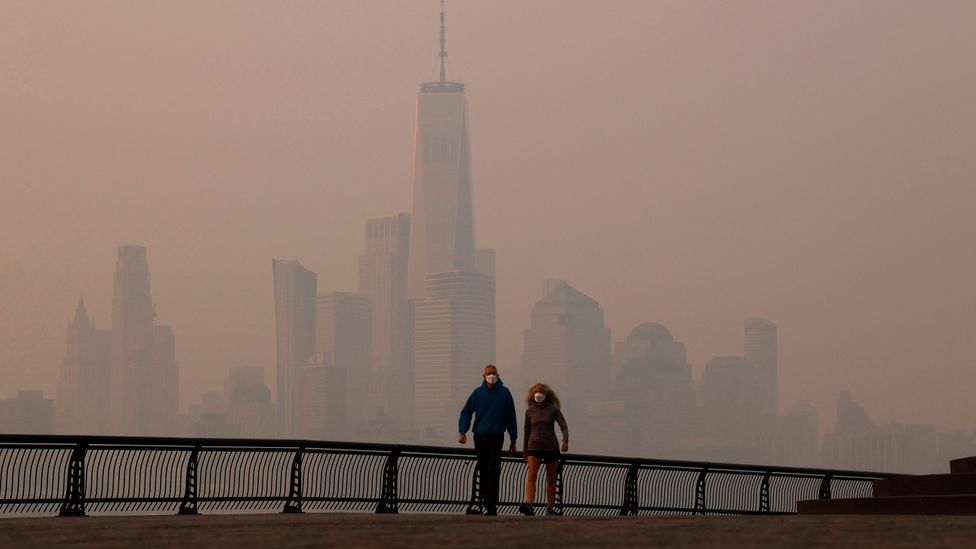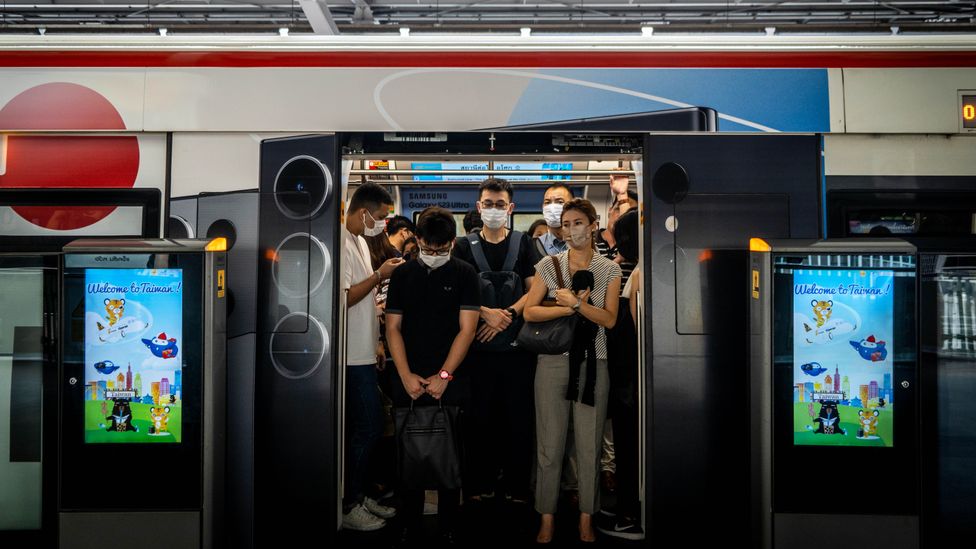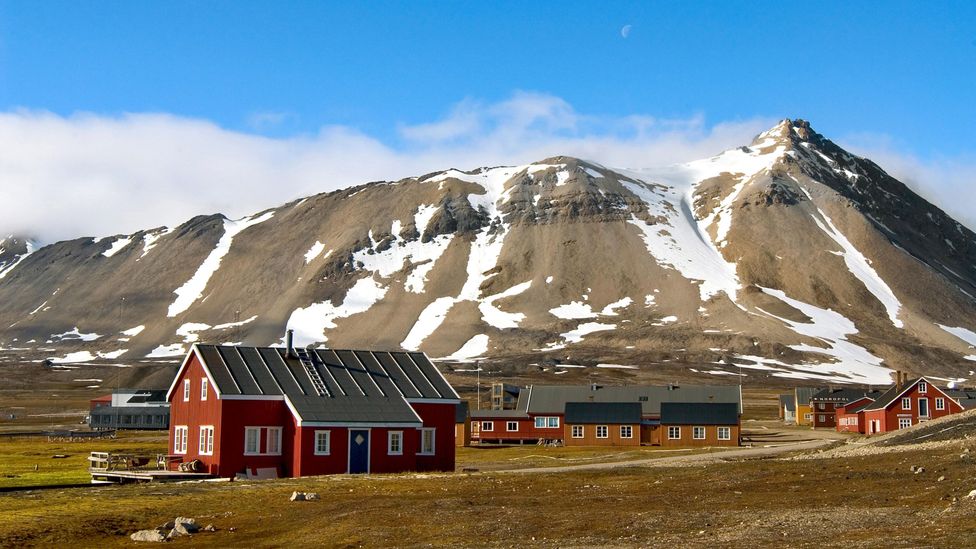All but 1% of the world's population is exposed to unhealthy air that exceeds World Health Organization limits for pollutants. In parts of the world, air quality has rapidly improved through policies that aim to limit pollution. But elsewhere, gains in air quality are at risk of being lost.
More than 25% of the US population is exposed to air considered "unhealthy" by the Environmental Protection Agency (EPA), according to a report by the climate non-profit First Street Foundation. By 2050, the number of people exposed to "unhealthy" days is set to increase by more than half. The worst days of air pollution ("hazardous" or maroon, under the EPA's system) are expected to rise by 27%.
Wildfire smoke is one of the factors driving this trend. One study of PM2.5 (see fact box: What is PM2.5?) from wildfire smoke found that levels had increased by up to 5 micrograms per cubic metre in the western US in the past decade – enough to reverse "decades of policy-driven improvements in overall air quality", the authors concluded.
What is PM2.5?
PM2.5 is a type of air pollution made up of "particulate matter" measuring 2.5 micrometres across or less – roughly 30 times smaller than the width of a human hair.
These tiny particles can be made up of a mixture of solid and liquid substances, varying in their chemical composition, including carbon, metals and organic compounds.
These specks of airborne soot, dust and other substances can trigger inflammation, which may cause damage the neural connections in the brain.
To put this in context – one study found that a quarter of the US's PM2.5 pollution was caused by wildfire smoke. In western regions, as much as half was caused by smoke. In 2023, large portions of the US saw significant dips in air quality and visibility as smoke from wildfires north of the Canadian border billowed across the continent. With climate change expected to increase the risk of wildfires around the world, it is likely that air quality will also suffer.
People who have existing respiratory conditions and newborns with developing lungs are the most affected by wildfire smoke. (See factbox: "How to protect yourself from wildfire smoke".)
As climate change makes wildfires more intense, here are some of the profound and unexpected ways air pollution affects our bodies, and what we can do to minimise exposure.
The far-reaching effects of wildfire smokeWildfires are not just a local problem to people who live near forests, peatlands and grasslands. Fires can send plumes of smoke up to 14 miles (23km) into the stratosphere, from where they spread all over the globe. In 2023, Siberian wildfires fuelled by unusually warm temperatures released smoke that travelled across the Pacific Ocean to reach Alaska and Seattle.

Wildfire smoke is contributing a large share of PM2.5 pollution in New York (Credit: Getty Images)
The health risks that come with wildfire air pollution depend in part on what's on fire – in Siberia, 2020, it was resinous boreal forest and peat, releasing record-breaking quantities of pollution, including high quantities of mercury. Another typical pollutant released in wildfires is PM2.5, particulate matter that measures 2.5 micrometres across or less, linked to respiratory conditions. (Read about the risks of PM2.5 and nanoparticle pollution here, and the link between air pollution and respiratory disease here.)
Wildfire smoke has been found to be harmful to certain immune cells in the lungs, with a toxicity four times greater than particulates from other types of pollution. And it gets worse as smoke ages: one study found the toxicity of smoke doubled in the hours after it was first emitted, reaching a peak of four times greater toxicity.
How to protect yourself from wildfire smoke
Sometimes you may not know if there is elevated wildfire smoke in your area. If there is a wildfire nearby, the Centers for Disease Control and Prevention advise taking steps to limit your exposure where possible:
- Choose a room to close off from outside air
- Wear a tightly fitting respirator, if it is safe for you to do so
- Keep track of fires nearby using services such as AirNow's fire and smoke map
- Pay attention to health symptoms and seek medical care if needed
Read the full advice on protection from wildfire smoke from the CDC online.
"Even if someone is far away from a fire source, they may still experience adverse health outcomes from the inhalation of highly diluted and oxidised smoke," Athanasios Nenes, an atmospheric chemist at the Swiss Federal Institute of Technology Lausanne told Allison Hirschlag for BBC Future.
Read Allison Hirschlag's full story on the health impacts of wildfire smoke.
How air pollution affects your brainThere is growing evidence that air pollution not only affects our physical health, but also our mental health. It has been linked to impaired judgement, poorer performance in school and even higher levels of crime. Researchers point to prolonged exposure to pollutants such as PM2.5.
But the picture is not a simple one. Exposure to air pollution is far from equal – despite how it might seem, we don't all breathe the same air. Often the most polluted areas in a city, for example, are in the poorest neighbourhoods. These are areas also afflicted by other problems that affect health, educational achievement and crime levels. Confounding factors such as investment in education, diet, smoking, drug use and alcohol consumption can also have an effect.
Nonetheless, researchers are increasingly concerned about the effect that air pollution may be having on our brains, as Melissa Hogenboom explains in this feature, where you can learn more about the emerging evidence.
Air pollution and weight gainWhile the exact mechanism is still debated, it is thought that the inflammation caused by air pollution may also affect the body's metabolism. Research has linked airborne pollution such as PM2.5 to obesity. Children living in the most polluted areas, for example, are more than twice as likely to be considered obese.
There is also growing evidence that air pollution may also play a role in the development of related conditions such as type 2 diabetes. One major analysis estimated that a fifth of the global burden of type 2 diabetes could be attributed to exposure to PM2.5 pollution. Other studies have suggested that another type of understudied air pollution, airborne microplastics, could also be disrupting the hormones that regulate our metabolism.
Learn more about how city life affects your health and happiness in this feature by William Park.
Air pollution is harming our sense of smellExposure to toxic air may also be eroding our olfaction. A 2021 study found that people who suffered from loss of smell, known as anosmia, in Baltimore, Maryland lived in areas with "significantly high" levels of PM2.5. An Italian study found that the noses of teenagers and young adults became less sensitive to odours following exposure to nitrogen dioxide, a component in traffic fumes.

Hazardous air pollution levels in cities contributes not just to respiratory problems, but conditions including type 2 diabetes (Credit: Getty Images)
Scientists say that pollution particles trigger inflammation and slowly wear away the nerves in the olfactory bulbs, which transmit smell information from the nose to the brain.
Anosmia disproportionately affects older people. A Swedish study also identified a strong association between higher pollution levels and poorer olfaction in people aged 60 and over.
Read more in our feature by Tim Smedley on how air pollution is causing us to lose our sense of smell.
Clean air is not an option for everyone
Almost everyone in the world now breathes air that is polluted in some way. But those who are worst hit by air pollution are also those who are least able to be able to protect themselves or escape from it. An estimated 716 million people with the lowest incomes globally live in areas with unsafe levels of air pollution. Even in the relatively wealthy, developed nations of Europe and North America, the toll taken by air pollution is borne predominantly by those who are least well off or from minority communities that face systemic inequalities.
A major source of these fine particulates is the burning of fossil fuels, and in particular petrol and diesel from vehicles. They can penetrate deep into the lungs and can cross into the blood stream where they are thought to increase levels of inflammation. They have been linked to a number of chronic long-term health issues including heart disease, lung problems and cancers.
In the US, PM2.5 pollution is the largest environmental health threat, with black and minority groups facing greater exposure than non-Hispanic white people. The poorest regions in Europe too tend to experience levels of PM2.5 concentrations that are a third higher than the richest. (Read about the young people fighting the worst smog in Europe.)
You can read more about the story of how air pollution creates environmental inequality around the world in this in-depth feature by Kamala Thiagarajan.
Where can you find the world's cleanest air?To map the long journeys that air pollution takes in atmospheric currents, scientists rely on monitoring stations that take near constant samples of air quality. One of those is the Zeppelin Observatory above the tiny town of Ny-Ålesund in Svalbard, Norway.

The tiny village of Ny-Ålesund on Svalbard, Norway, is one of the few places in the world with extremely clean air (Credit: Alamy)
This settlement, which boasts a population of just 45 people in winter and is 765 miles (1,230km) from the North Pole, grew up around the coal-mining industry in the first half of the 20th Century. Today, it has some of the cleanest air on the planet.
But that is also changing – levels of methane have been growing in the air around the town, while levels of sulphate, particulates and metals are also spiking.
Another candidate for the world's most pristine air can be found on the north-western tip of Tasmania, Australia. Cape Grim, or Kennaook, where winds whip across the Southern Ocean unimpeded. As it doesn't pass over any landmasses or populated areas enroute, the air is unaffected by local sources of pollution such as exhaust fumes. Learn more about Cape Grim in this feature by Dani Wright and find out more about how the air around Ny-Ålesund is changing in this feature by Anna Filipova.
Other remote clean air sites around the world include Mauna Loa station in Hawaii, Macquarie Island and Casey Station in Antarctica.
But for those 99% of us who live far from this pristine air, some of the most impactful changes to help bring down air pollution include lowering emissions in cities from road transport, moving to cleaner ways of cooking, rapidly reducing the use of fossil fuels and a range of ways to prevent wildfires in the first place.
--
If you liked this story, sign up for The Essential List newsletter – a handpicked selection of features, videos and can't-miss news delivered to your inbox every Friday.
Join one million Future fans by liking us on Facebook, or follow us on Twitter or Instagram.
